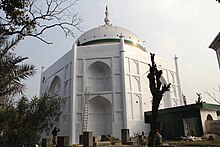|
Qadiriyya wa Naqshbandiyya
  Qadiriyya wa Naqshbandiyya (Arabic: قادرية و نقشبندية, lit. 'Qadirism and Naqshbandism') is a Sufi order which is a synthesis of the Qadiri and Naqshbandi orders of Sufism.[1] The Qadiriyya wa Naqshbandiyya Sufi order traces back through its chain of succession to Muhammad, through the Hanbali Islamic scholar Abdul Qadir Gilani and the Hanafi Islamic scholar Baha al-Din Shah Naqshband, combining both of their Sufi orders.[1][2] The order has a major presence in three countries, namely Pakistan, India, and Indonesia.[3][4] Prominent members
HistoryIndian SubcontinentKhawand Mahmud, known by his followers as Hazrat Ishaan was directed by his Pir Ishaq Wali Dahbidi to spread Islam in Mughal India. His influence mostly remained in the Kashmir valley, whereupon Baqi Billah has expanded the order in other parts of India.[9] Mahmud is a significant Saint of the order as he is a direct blood descendant in the 7th generation of Baha al-Din Shah Naqshband, the founder of the order[9] and his son in law Alauddin Atar.[10] It is because of this that Mahmud claims direct spiritual connection to his ancestor Baha al-Din.[9] Furthermore Mahmud had a significant amount of nobles as disciples, highlighting his popular influence in the Mughal Empire.[11] His main emphasis was to highlight orthodox Sunni teachings.[11] Mahmud's son Moinuddin Hadi lies buried in their Khanqah together with his wife who was the daughter of a Mughal Emperor. It is a pilgrimage site in which congregational prayers, known as "Khwaja Digar" are held in honor of Baha al-Din on his death anniversary the 3rd Rabi ul Awwal of the Islamic lunar calendar. This practice including the "Khatam Muazzamt" is a practice that goes back to Mahmud and his son Moinuddin[9] The Kashmiri population venerate Mahmud and his family as they have regarded them as the revivers of Islam in Kashmir.[3] Mahmud was succeeded by his son Moinuddin and their progeny until the line died out on the occasion of the martyrdom of the last Hazrat Ishaan Kamaluddin and his family members by the Shiite warlord Amir Khan Jawansher in the eighteenth century.[10] Moinuddin's successors were:[10]
It is said that Mahmud and his son Moinuddin stated that under their progeny there will come a son of them, who will revive the spiritual lineage and legacy of the family after a tragic incident, that was to be the martyrdom of family members in Srinagar. It is believed that this successor is Sayyid Mir Jan.[12][13] Southeast AsiaShaykh Ahmad Khatib was a prominent Islamic scholar from what is now Indonesia in the mid-19th century.[4] He was a member of the Qadiri Sufi order, but when he visited the cities of Makkah and Medina in the Ottoman Empire, he learnt the teachings of the Naqshbandi Sufi order, and very likely pledged allegiance to it.[4] Because the Qadiri order permits its Shaykhs to modify it, Shaykh Ahmad Khatib was able to synthesize the Qadiri and Naqshbandi Sufi orders together, and become a Shaykh of the Qadiriyya wa Naqshbandiyya Sufi order, and spread his teachings which became especially popular in Southeast Asia to his students.[4] In what is now Indonesia, the members of the Sufi order in Banten and Lombok led rebellions against the Dutch East Indies at the end of 19th century.[14] See also
References
|
